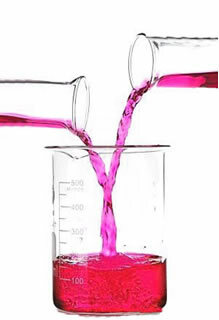When preparing an aqueous solution of NaCN (sodium cyanide), we find that its pH is greater than 7, therefore it constitutes a strong base. Follow the hydrolysis analysis of this salt:
When adding NaCN base in a neutral medium (water), it makes the solution basic (pH > 7).
The classic equation of the process is:
The products of the reaction are:
NaOH (sodium hydroxide): strong base
HCN (hydrocyanic acid): weak acid
The following two rules are useful for obtaining the equation of the salt hydrolysis process:
1. Dissociate the salt (separate the cation from the anion)
2. Dissociate the strong base (COH → C+ +OH-)
• NaCN, being a soluble salt, is dissociated:
NaCN → Na+ + CN-
• NaOH, as it is a strong base, is dissociated:
NaOH → Na+ + OH-
Thus, the most correct way to represent the reaction is:
Do not stop now... There's more after the advertising ;)
CN- (aq) + H2O(l) ↔ OH- (aq) +HCN(aq)
Note that the hydrolysis (breaking the molecule through water) was of the CN- anion, that is, the ion coming from the weak acid.
Generic equation of anion hydrolysis: THE- + HOH → HA + OH-
Conclusion: weak acid salt and strong base give the solution basic character (pH > 7). The presence of the OH- ion justifies the basic medium.
By Líria Alves
Graduated in Chemistry
Brazil School Team
See more!
Salt hydrolysis of strong acid and weak base
saline hydrolysis
Physicochemical - Chemistry - Brazil School
Would you like to reference this text in a school or academic work? Look:
SOUZA, Líria Alves de. "Saline hydrolysis of weak acid and strong base"; Brazil School. Available in: https://brasilescola.uol.com.br/quimica/hidrolise-salina-acido-fraco-base-forte.htm. Accessed on June 28, 2021.


